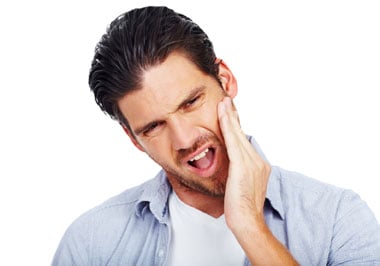… and the neck, ear, temple or cheek! And what about those headaches? Say hello to the temporomandibular joint (TMJ). It’s a seldom thought-of but hard-working part of the body that allows us to talk, chew, eat, swallow and yawn. Let’s discuss what’s right with the TMJ, what happens when things go wrong with it and what we can do about it.
The physics of the Temporomandibular Joint
The joint is located where the jawbone connects to the temporal bone on the side of your skull. You can easily locate it by placing your fingertips lightly on the sides of your face, in front of your ears. When you open your mouth, you can feel the rounded ends, or condyles, of the jawbone as they slide out the joint socket. The condyles will ‘disappear’ from your touch as they go back into the joint socket when you close your mouth. The smooth (we hope), sliding action that you feel is made possible by a small disc of cartilage that lies between the jawbone and the side of the skull.
That little disc of cartilage absorbs a tremendous amount of force. The average bite force is around 70 kgs, with night-time clenching or grinding exceeding 250kgs! Because the jawbone acts like a lever, and the joint serves as a fulcrum (remember your high-school physics?), the joint itself receives even more force. Fortunately, the cartilage disc lubricates and cushions this, spreading the force over the joint space and allowing us to keep on chewing. Without this cartilage, our poor TMJ’s would quickly ‘grind’ to a halt!
When good TMJ’s go bad
Unfortunately, sometimes things go wrong with this complex structure. Trauma, for example, from being in a car accident or getting knocked in the jaw, are sources of TMJ pain. If the cartilage becomes displaced—like a slipped disc—it can put pressure on the nerves in the jaw while at the same time becoming less effective for absorbing the friction and pressures that come from using the jaw joint. Habits such as fingernail biting, clenching and grinding at night can cause the muscles that move the jaw to spasm and cause pain and tenderness.
Obviously, if your jaw hurts—especially in front of the ear—that’s an indication that things maybe wrong. The pain may be sharp and sudden whenever you bite or chew, or it may become a dull and constant ache. Sometimes the pain is so strong and so associated with the ear that patients will seek out an ear specialist, convinced they have an ear infection.
TMJ dysfunction can also produce a range of symptoms, such as:
- Popping and clicking of the jaw when opening and closing the mouth
- Locking of the jaw, making it difficult to close
- Difficulty in fully opening the mouth.
- Frequent headaches or neck pain and stiffness.
Bringing your TMJ back into balance
Fortunately, with early detection, simple and safe treatments for TMJ dysfunction can be quite effective. Lifestyle changes such as exercise or restricting caffeine can reduce stress that leads to night-time grinding or jaw clenching that strains the joint. Other remedies suggested for treatment at the early stages include:
- Eating soft foods to rest the muscles involved.
- Avoid chewing gum and excessive jaw clenching.
- Massage and relaxation techniques.
- Physiotherapy with a specialist jaw joint physiotherapist.
- Acupuncture.
- Moist heat can be applied several times daily to further relax the jaw.
- In the case of an injury to the jaw, ice packs can be applied to prevent or reduce swelling.
Severe or chronic TMJ dysfunction requires a more intensive approach using the above and in extreme cases, surgery may be required to relieve pain.
As with many other dental issues, catching a problem early makes correction and treatment so much easier.


